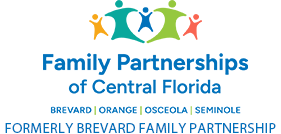
Hurricane season is upon us and officially spans from June 1 through November 30. Brevard Family Partnership’s Disaster Preparedness Plan lays out a detailed plan of action steps, tasks, and responsibilities (both pre and post-storm) that ensures the safety and protection of children, families, and team members. BFP added a new emergency alert notification system to disperse immediate critical updates and to increase communication. A well-thought-out plan goes a long way toward reducing the damage from hurricanes or any other type of disaster that strikes. Of the utmost priority is safety. Weathering the storm safely is the primary issue, in addition to maintaining sound mental and physical well-being. Get ready now with these easy, low-cost steps that will leave you better prepared.
Enhance Awareness: Stay aware of the weather by paying attention to meteorologists’ forecasts, and following the instructions from emergency management officials. Informational updates regarding tropical storms and hurricanes are available through the National Hurricane Center. Forecasters at the center issue storm surge watches and warnings and advisories, watches, and warnings for disturbances that aren’t yet tropical cyclones but still threaten land with a tropical storm or hurricane conditions within 48 hours. The center added an experimental visualization tool to easily see when damaging winds are predicted and a new hurricane track cone graphic to see how far the hurricane or tropical storm-force winds will extend outside of the cone.
Know Your Evacuation Routes: It’s the worst-case scenario, but if evacuation is required before a storm hits, have a solid plan in place. Know your evacuation routes ahead of time and keep your car filled with gas. If an official evacuation order is executed, leave as early and expeditiously as possible. Choose a destination close to home to minimize drive time. If a motel or hotel is the identified evacuation destination, call ahead to make your reservations because it may be booked by the time you arrive. In addition to friends and family, a nearby shelter can also serve as a safe haven. Click here to view Brevard County Shelter Information or Download FEMA’s mobile app to assist you and your family in finding the closest shelter near you. Wait until an area is declared safe before returning home.
Prepare an Emergency Care Kit: Assemble a survival kit that is readily available. FEMA recommends having enough food and water to last for at least three days for every family member. That includes roughly one gallon of water per person for three days for both drinking and hygienic purposes. Stock up on shelf-stable, ready-to-eat food items like canned meats and vegetables, granola or protein bars, nuts, peanut butter, and non-perishable milk (think: nutrient-dense, high energy foods). Keep a manually-operated can opener for your canned food as well as any needed utensils. Keep a “go bag” for use during a storm or in the event of evacuation that includes food, water, flashlights, batteries, chargers, a first aid kit, sanitation and hygiene items and needed medication. Have a battery-operated radio on hand to stay apprised of updates in the event of loss of power and cell phone service. Set aside an emergency fund of cash and coins as ATMs may not be working, and or difficult to get to. Store personal documents (passports, birth certificates, insurance policies, etc.) in a waterproof container placed in a secure area, preferably on higher ground and away from windows.
Exercise sound precautions against flood water, high winds, and lightning: Before the storm hits, clear outdoor drains and remove excess debris to allow for proper stormwater drainage. Bring in garbage cans, bicycles or unsecured furniture from outside that may become airborne or float away during the storm. If available, park your vehicle in the garage, out of the elements. Ensure windows and doors are secured. Unplug appliances where the threat of lightning may pose as an additional hazard.
Ensure a well -defined Family Disaster Plan: Discuss and practice what each family member will do in the event of a weather disaster. FEMA recommends identifying both a central meeting place and an out-of-town contact for families to touch base with if separated. Post emergency telephone numbers by phones and ensure awareness of how and when to call 911. Teach family members how to use text messaging and subscribe to alert services as soon as a storm is reported.
Ensure a plan for your pets: Make sure each pet is wearing identification. A microchip is the best insurance against getting your pet lost. If your pet isn’t micro-chipped, keep a photo of you and your pet in your emergency kit in the case of separation. Make arrangements with family and friends for pet care away from danger as early as possible. Do not to leave your animal behind. Check out pet-friendly shelters in Brevard County.
Protective measures and actions such as these are designed to increase safety. Remember that recovering from a disaster is usually a gradual process. Understanding the emotions and normal responses that follow a disaster or other traumatic event can help with coping with feelings, thoughts, and behaviors.








